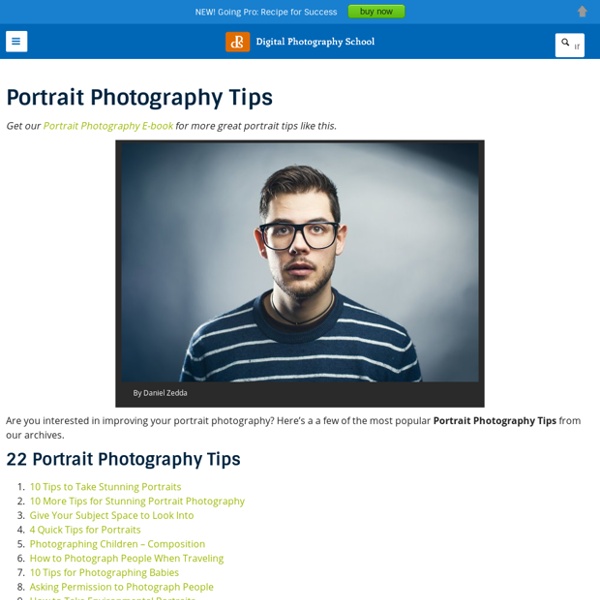



Portrait Photography guide and tips from Photo.net A face devoid of love or grace, A hateful, hard, successful face, A face with which a stone Would feel as thoroughly at ease As were they old acquaintances,-- First time together thrown. -- "A Portrait" by Emily Dickinson Below are two photos by world-famous portrait photographer: Elsa Dorfman. Elsa has the same kind of studio, background, lights, and equipment as a lot of folks with more technical skill. Yet those folks aren't portrait photographers and Elsa is. What's the difference? Elsa cares about people. Elsa uses a 20x24" Polaroid camera. Elsa's artistic success implies that the most important thing about portrait photography is an interest in your subject. Location If you don't have or can't create a photo studio, concentrate on environmental portraiture. There are two elements to a photo studio for portrait photography. The second element of a portrait studio is controlled lighting. Stealing a Location Lighting The most flattering light for most portraits is soft and off-camera.
Documentary photography Documentary photography usually refers to a popular form of photography used to chronicle significant and historical events. It is typically covered in professional photojournalism, or real life reportage, but it may also be an amateur, artistic, or academic pursuit. The photographer attempts to produce truthful, objective, and usually candid photography of a particular subject, most often pictures of people. History[edit] The term documentary applied to photography antedates the mode or genre itself. Photographs meant to accurately describe otherwise unknown, hidden, forbidden, or difficult-to-access places or circumstances date to the earliest daguerreotype and calotype "surveys" of the ruins of the Near East, Egypt, and the American wilderness areas. Both the Civil War and USGS photographic works point up an important feature of documentary photography: the production of an archive of historical significance, and the distribution to a wide audience through publication. See also[edit]
Portrait photography Natural light portraiture Portrait of a girl in costume in the natural environment of a gothic festival. Portrait photography or portraiture is photography of a person or group of people that displays the expression, personality, and mood of the subject. Like other types of portraiture, the focus of the photograph is usually the person's face, although the entire body and the background or context may be included. History[edit] Portrait photographs have been made since virtually the invention of the camera. Lighting for portraiture[edit] Winter portrait of a 10-month old babygirl When portrait photographs are composed and captured in a studio, the photographer has control over the lighting of the composition of the subject and can adjust direction and intensity of light. Three-point lighting[edit] One of the most basic lighting plans is called three-point lighting. Key-Light[edit] Fill light[edit] Accent-Light[edit] Accent-lights serve the purpose of accentuating a subject. Kicker[edit]
Child Photography Tips "The ever changing subject. They just grow up too quick." Child photography is one of the most rewarding fields of photography. I have been a photographer for a while now and I would have to say that my favorite subject to photography is my son. I mean, just look at that face. One of the biggest reasons that parents love photographing their children is that the subject changes (grows up) so quickly. The articles linked below will show the techniques that photographers use to capture the character and blissfulness of childhood. Baby Poses - Helpful guide for photographers looking for baby poses and baby photography ideas. Child Action Photography - Face it, children are quick. Baby Props - Photographing babies or toddlers requires skill, patience, and good baby props. Fill the Viewfinder - The child should be prominent in the scene, not just part of it. Don't Be a Stranger - Parents raise their children no to go near strangers. Return to the top of Child Photography, or Photography Tips.
Wedding Photography – 21 Tips for Amateur Wedding Photographers “Help me – I’m photographing my first Wedding!… Help me with some Wedding Photography Tips Please!” It’s a question that’s been asked a few times in our forums over the last few months so while I’m not a Pro Wedding Photographer I thought it was time to share a few tips on the topic of Wedding Photography. I’ll leave the technical tips of photographing a wedding to the pros – but as someone who has been asked to photograph numerous friends and family weddings – here are a few suggestions. 1. One of the most helpful tips I’ve been given about Wedding Photography is to get the couple to think ahead about the shots that they’d like you to capture on the day and compile a list so that you can check them off. 2. I find the family photo part of the day can be quite stressful. 3. Visit the locations of the different places that you’ll be shooting before the big day. 4. So much can go wrong on the day – so you need to be well prepared. 5. Show them your work/style. 6. 7. 8. 9. 10. 11. 12. 13.
Wedding photography A wedding in 1942 - with the bride wearing a traditional white wedding dress Wedding photography is the photography of activities relating to weddings. It encompasses photographs of the couple before marriage (for announcements, portrait displays, or thank you cards) as well as coverage of the wedding and reception (sometimes referred to as the wedding breakfast in non-US countries). It is a major commercial endeavor that supports the bulk of the efforts for many photography studios or independent photographers. Like the technology of photography itself, the practice of wedding photography has evolved and grown since the invention of the photographic art form in 1826 by Joseph Nicéphore Niépce.[1] In fact, an early photograph, recorded some 14 years after the fact, may be a recreation for the camera of the 1840 wedding of Queen Victoria to Prince Albert. Technology[edit] During the film era, photographers favored color negative film and medium-format cameras, especially by Hasselblad.